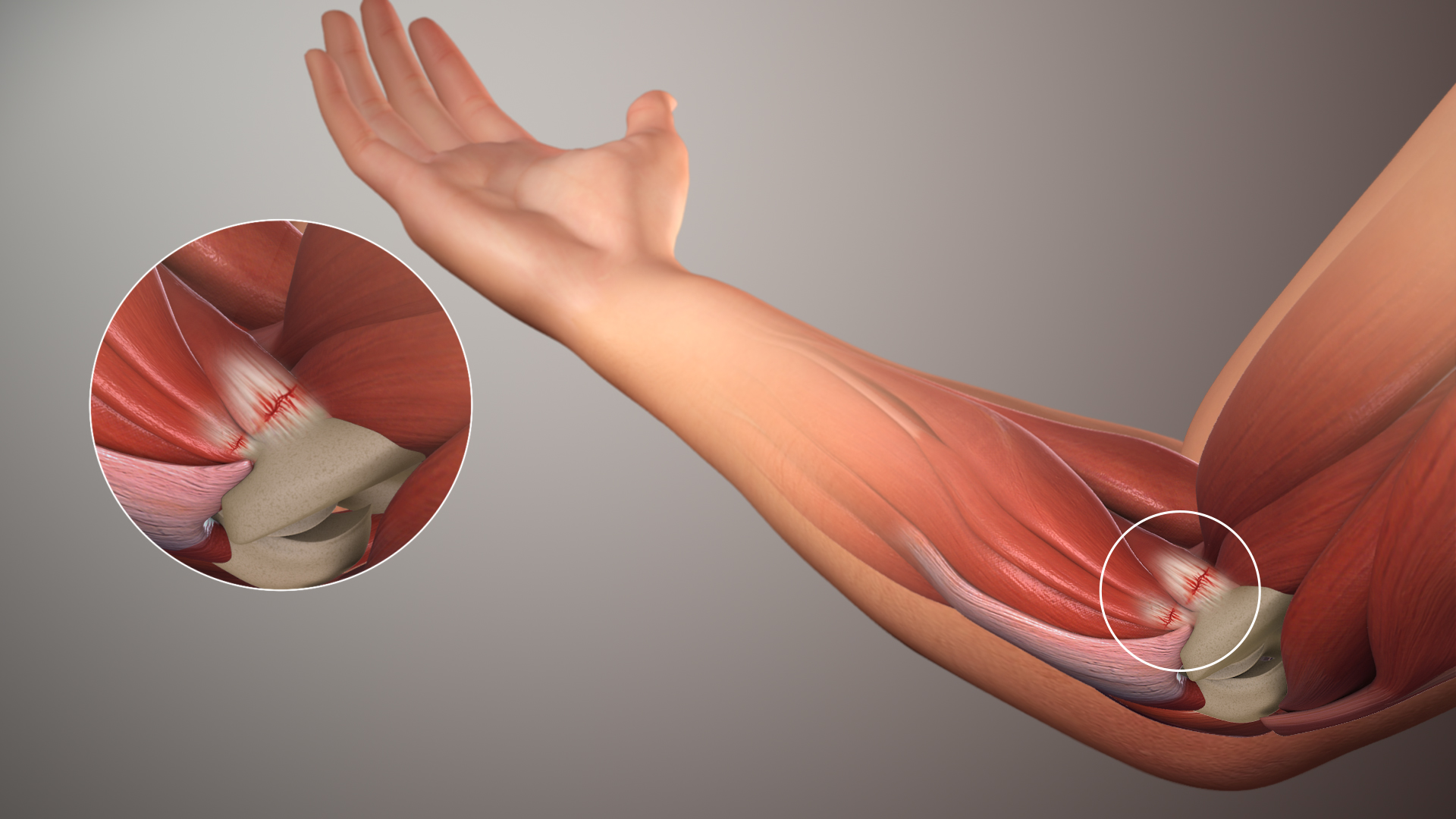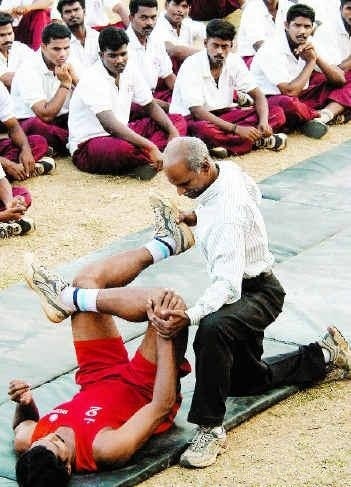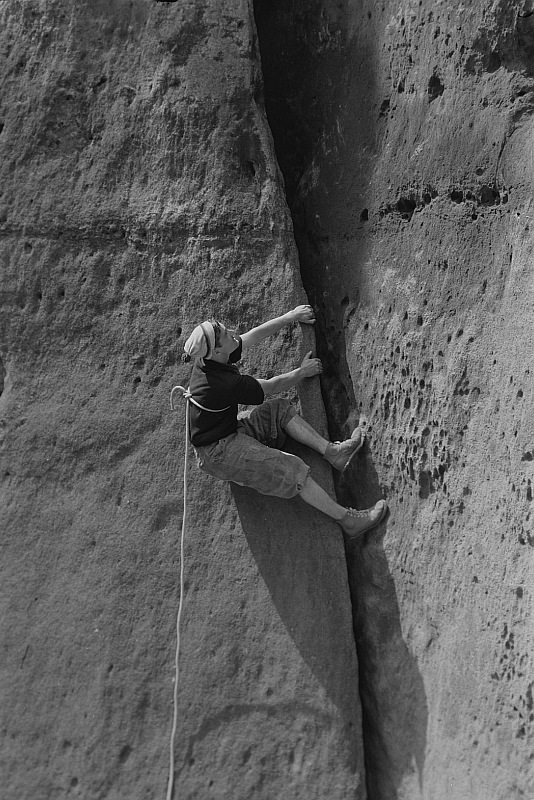|
Climbing Injuries
Injuries in rock climbing may occur due to falls, or due to overuse (see Sports injury). Injuries due to falls are relatively uncommon; the vast majority of injuries result from overuse, most often occurring in the fingers, elbows, and shoulders. Such injuries are often no worse than torn calluses, cuts, burns and bruises. However, overuse symptoms, if ignored, may lead to permanent damage (esp. to tendons, tendon sheaths, ligaments, and joint capsules). Risk groups The climbers most prone to injuries are intermediate to expert within lead climbing or bouldering. Overuse injuries in climbing In terms of overuse injuries a British study found that: * 40% occurred in the fingers * 16% in the shoulders * 12% in the elbows * 5% in the knees * 5% in the back * 4% in the wrists One injury that tend to be very common among climbers is Carpal tunnel syndrome. It is found in about 25% of climbers. Finger injuries 604 injured rock climbers were prospectively evaluated from January 1998 to ... [...More Info...] [...Related Items...] OR: [Wikipedia] [Google] [Baidu] |
Rock Climbing
Rock climbing is a sport in which participants climb up, across, or down natural rock formations. The goal is to reach the summit of a formation or the endpoint of a usually pre-defined route without falling. Rock climbing is a physically and mentally demanding sport, one that often tests a climber's strength, endurance, agility and balance along with mental control. Knowledge of proper climbing techniques and the use of specialized climbing equipment is crucial for the safe completion of routes. Because of the wide range and variety of rock formations around the world, rock climbing has been separated into several different styles and sub-disciplines, such as scrambling, bouldering, sport climbing, and trad (traditional) climbing another activity involving the scaling of hills and similar formations, differentiated by the rock climber's sustained use of hands to support their body weight as well as to provide balance. Rock climbing competitions have the objectives of either ... [...More Info...] [...Related Items...] OR: [Wikipedia] [Google] [Baidu] |
Golfer's Elbow
Golfer's elbow, or medial epicondylitis, is tendinosis of the medial epicondyle on the inside of the elbow. It is in some ways similar to tennis elbow, which affects the outside at the lateral epicondyle. The anterior forearm contains several muscles that are involved with flexing the digits of the hand, and flexing and pronating the wrist. The tendons of these muscles come together in a common tendinous sheath, which originates from the medial epicondyle of the humerus at the elbow joint. In response to minor injury, this point of insertion becomes inflamed, causing pain. Causes The condition is called ''golfer's elbow'' because in making a golf swing this tendon is stressed, especially if a non-overlapping (baseball style) grip is used; however, many people develop the condition without playing golf. It is also sometimes called ''pitcher's elbow'' due to the same tendon being stressed by the throwing of objects such as a baseball, but this usage is much less frequent. Other ... [...More Info...] [...Related Items...] OR: [Wikipedia] [Google] [Baidu] |
Sports Medicine
Sports medicine is a branch of medicine that deals with physical fitness and the treatment and prevention of injuries related to sports and exercise. Although most sports teams have employed team physicians for many years, it is only since the late 20th century that sports medicine emerged as a distinct field of health care. In some countries, sports medicine (or sport and exercise medicine) is a recognized medical specialty (with similar training and standards to other medical specialties). In the majority of countries where sports medicine is recognized and practiced, it is a physician (non-surgical) specialty, but in some (such as the USA), it can equally be a surgical or non-surgical medical specialty, and also a specialty field within primary care. In other contexts, the field of sports medicine encompasses the scope of both medical specialists and also allied health practitioners who work in the field of sport, such as physiotherapists, athletic trainers, podiatrists and ... [...More Info...] [...Related Items...] OR: [Wikipedia] [Google] [Baidu] |
Overuse Injuries
A repetitive strain injury (RSI) is an injury to part of the musculoskeletal or nervous system caused by repetitive use, vibrations, compression or long periods in a fixed position. Other common names include repetitive stress disorders, cumulative trauma disorders (CTDs), and overuse syndrome. Signs and symptoms Some examples of symptoms experienced by patients with RSI are aching, pulsing pain, tingling and extremity weakness, initially presenting with intermittent discomfort and then with a higher degree of frequency. Definition Repetitive strain injury (RSI) and associative trauma orders are umbrella terms used to refer to several discrete conditions that can be associated with repetitive tasks, forceful exertions, vibrations, mechanical compression, sustained or awkward positions, or repetitive eccentric contractions. The exact terminology is controversial, but the terms now used by the United States Department of Labor and the National Institute of Occupational Safe ... [...More Info...] [...Related Items...] OR: [Wikipedia] [Google] [Baidu] |
Climbing And Health
Climbing is the activity of using one's hands, feet, or any other part of the body to ascend a steep topographical object that can range from the world's tallest mountains (e.g. the eight thousanders), to small boulders. Climbing is done for locomotion, sporting recreation, and for competition, and is also done in trades that rely on ascension; such as emergency rescue and military operations. Climbing is done indoors and outdoors and on natural (e.g. rock and ice) and artificial surfaces. Professional mountain guides or rock climbing guides (e.g. the UIAGM), were a significant element in developing the popularity of the sport in the natural environment, and remain so today. Since the 1980s, the development of competition climbing and the availability of artificial climbing walls have dramatically increased the popularity of rock climbing as a sport and led to the emergence of professional rock climbers, such as Wolfgang Güllich, Chris Sharma, Lynn Hill and Catherine D ... [...More Info...] [...Related Items...] OR: [Wikipedia] [Google] [Baidu] |
Climbing Command
Rock climbing is a sport in which participants climb up, across, or down natural rock formations. The goal is to reach the summit of a formation or the endpoint of a usually pre-defined route without falling. Rock climbing is a physically and mentally demanding sport, one that often tests a climber's strength, endurance, agility and balance along with mental control. Knowledge of proper climbing techniques and the use of specialized climbing equipment is crucial for the safe completion of routes. Because of the wide range and variety of rock formations around the world, rock climbing has been separated into several different styles and sub-disciplines, such as scrambling, bouldering, sport climbing, and trad (traditional) climbing another activity involving the scaling of hills and similar formations, differentiated by the rock climber's sustained use of hands to support their body weight as well as to provide balance. Rock climbing competitions have the objectives of either ... [...More Info...] [...Related Items...] OR: [Wikipedia] [Google] [Baidu] |
Climbing Terminology
__NOTOC__ This glossary of climbing terms is a list of definitions of terms and jargon related to rock climbing and mountaineering. The specific terms used can vary considerably between different English-speaking countries; many of the phrases described here are particular to the United States and the United Kingdom. A B Completing the climb upon one's first attempt ever. Often confused with 'flashing' which is the first attempt of the day. There is a second opportunity for a climber to 'blitz' a wall after 12 months. C D E ... [...More Info...] [...Related Items...] OR: [Wikipedia] [Google] [Baidu] |
List Of Climbing Topics
This is an index of topics related to climbing. A Abseil - Acetazolamide - '' Action Directe'' - Altitude sickness (also known as: ''Acute mountain sickness'' (AMS)) - Aid climbing - Aider - Alcove (climbing) - knot - Alpine hut - Alpine style - Anchor (climbing) - Angle (climbing) - Arête - Ascension (climbing) - Australian rappel - Avalanche B Ball-nuts - Base camp - Bat hook - Belay - Belay device - Belay slave - Belay station - Big wall climb - Birdbeak - Bivouac or Bivi - Black ice - Blue ice - Boreal - Boulder - Bouldering - Bowline - Bowline on a bight - Bowyangs - Buildering - Butterfly knot C Cam - Campus (see campus board) - Campus board - Carabiner or Biner - Chimney (see Chimneying) - Chimneying - Chipped hold - Chipping - Choss - Chute - Cirque - Clean climbing - Cliff - Climbing area - Climbing command - Climbing equipment - Climbing gym - Climbing harness - Climbing injuries - Climbing route - Climbing shoe - Climbing technique - Climbing wall - ... [...More Info...] [...Related Items...] OR: [Wikipedia] [Google] [Baidu] |
Radial Tunnel Syndrome
Radial tunnel syndrome (RTS) is caused by increased pressure on the radial nerve as it travels from the upper arm (the brachial plexus) to the hand and wrist. Symptoms and signs Radial tunnel syndrome causes posterolateral elbow pain that is similar to tennis elbow and may sometimes occur in conjunction with that condition. Patients may typically have weakness of extension at the wrist and third digit. The pain is often reproduced upon resisted supination of the forearm, and pain at the radial tunnel on resisted hyperextension of the wrist. Cause The theory is that the radial nerve becomes irritated and/or inflamed from friction caused by compression by muscles in the forearm. Some speculate that radial tunnel syndrome is a type of repetitive strain injury (RSI), but there is no detectable pathophysiology and even the existence of this disorder is questioned. The term "radial tunnel syndrome" is used for compression of the posterior interosseous nerve, a division of the radial ne ... [...More Info...] [...Related Items...] OR: [Wikipedia] [Google] [Baidu] |
Repetitive Strain Injury
A repetitive strain injury (RSI) is an injury to part of the musculoskeletal or nervous system caused by repetitive use, vibrations, compression or long periods in a fixed position. Other common names include repetitive stress disorders, cumulative trauma disorders (CTDs), and overuse syndrome. Signs and symptoms Some examples of symptoms experienced by patients with RSI are aching, pulsing pain, tingling and extremity weakness, initially presenting with intermittent discomfort and then with a higher degree of frequency. Definition Repetitive strain injury (RSI) and associative trauma orders are umbrella terms used to refer to several discrete conditions that can be associated with repetitive tasks, forceful exertions, vibrations, mechanical compression, sustained or awkward positions, or repetitive eccentric contractions. The exact terminology is controversial, but the terms now used by the United States Department of Labor and the National Institute of Occupational Safe ... [...More Info...] [...Related Items...] OR: [Wikipedia] [Google] [Baidu] |
Climber's Finger
Climber's finger is one of the most common climbing injuries within the sport of rock climbing, accounting for about 30% of finger injuries seen in climbers. It is an overuse injury that usually manifests in a swollen middle or ring finger due to a damaged flexor tendon pulley, normally the A2 or A4 pulley. It is particularly common after a repeated utilization of small holds. Continued climbing on an injured finger may result in increased downtime in order to recover. The injury was first described in 1988 by Dr. S.R. Bollen. __TOC__ Cause Rock climbers often support their body with bent fingers on small edges, known as "crimps", especially on more difficult routes. This can cause a characteristic injury to the pulleys (annular ligaments), named "climber's finger". Treatment Management of pulley injuries of the fingers is to follow the RICE method. Other treatment suggestions are listed below: * The patient is to immediately cease climbing and any other activity that puts stre ... [...More Info...] [...Related Items...] OR: [Wikipedia] [Google] [Baidu] |
Magnesium Carbonate
Magnesium carbonate, (archaic name magnesia alba), is an inorganic salt that is a colourless or white solid. Several hydrated and basic forms of magnesium carbonate also exist as minerals. Forms The most common magnesium carbonate forms are the anhydrous salt called magnesite (), and the di, tri, and pentahydrates known as barringtonite (), nesquehonite (), and lansfordite (), respectively. Some basic forms such as artinite (), hydromagnesite (), and dypingite () also occur as minerals. All of those minerals are colouress or white. Magnesite consists of colourless or white trigonal crystals. The anhydrous salt is practically insoluble in water, acetone, and ammonia. All forms of magnesium carbonate react with acids. Magnesite crystallizes in the calcite structure wherein is surrounded by six oxygen atoms. The dihydrate has a triclinic structure, while the trihydrate has a monoclinic structure. References to "light" and "heavy" magnesium carbonates actually refer to ... [...More Info...] [...Related Items...] OR: [Wikipedia] [Google] [Baidu] |







